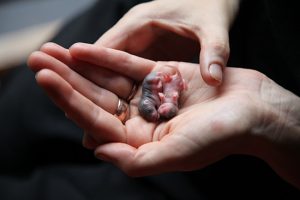 Canadian art duo Duke and Battersby explore a kaleidoscope of emotions through the lenses of old letters, video art, drawings, sculpture and cats. Over the past 15 years, Emily Vey Duke and Cooper Battersby have become renowned in the art world for their charming, yet sinister work. In 2005 they received Aliant’s New Media Award and were shortlisted for the Sobey Art Award. Their short films have also inspired a collection of essays called The Beauty Is Relentless, available through Coach House. (They also designed the amusingly meta cover of our 50th issue.) Their latest exhibition Pain Shall Be No More is currently on display at Toronto’s Gallery West and sorts through the various degrees of longing, loss, and the traces left behind.
Canadian art duo Duke and Battersby explore a kaleidoscope of emotions through the lenses of old letters, video art, drawings, sculpture and cats. Over the past 15 years, Emily Vey Duke and Cooper Battersby have become renowned in the art world for their charming, yet sinister work. In 2005 they received Aliant’s New Media Award and were shortlisted for the Sobey Art Award. Their short films have also inspired a collection of essays called The Beauty Is Relentless, available through Coach House. (They also designed the amusingly meta cover of our 50th issue.) Their latest exhibition Pain Shall Be No More is currently on display at Toronto’s Gallery West and sorts through the various degrees of longing, loss, and the traces left behind.
Shannon Webb-Campbell: What can we expect from your show Pain Shall Be No More?
Duke and Battersby: Pain Shall Be No More is an exhibition of sculpture, video and works on paper. The title comes from a poem by R. J. Macsween. He was a critic, poet and priest from Cape Breton, and he taught English at St. F X for many years. In his poetry, it becomes clear that the guy was battling some demons. Basically, the gist of Pain Shall Be No More, the poem, is that the pain will stop when we die and not before. It’s not a great poem, I don’t think, but it’s funny and sad at the same time, our favorite combination.
Do you believe in reincarnation?
No, not exactly, although I do believe in the laws of thermodynamics, which state where no energy is truly lost. It’s just transmitted from one form to another. Rotting is an easy way to understand this: the energy that was once in an animal is transformed into microbes, bacteria, bugs, etc. when the animal’s body decays. This is a kind of reincarnation. But I don’t believe any of that spiritual mumbo-jumbo. The great thing about nature is that it is indifferent. Good people and bad people rot the same.
Where did you draw inspiration for Pain Shall Be No More?
So much of our thinking centers around conversations we have with one another. Also, a great deal comes from engaging with our habitat. We live in the country with a lot of bugs; four cats and whatever half-dead creatures they bring us to nurse back to health. That keeps things in perspective. We try to make work about things that are a big deal to us and in the world at large. I see so much art that feels trivial, doesn’t deal with feelings, and is only self-reflexive. I understand that, and people make art for all different reasons, but for us that’s not enough.
Why do you make art?
We make art because we have things we want to say that we think people want to hear. Some people. Sometimes. We’re not greedy –that’s good enough for us.
What has been your greatest achievement as artists?
Moving people.
What does your collective creative process look like?
Well, we talk first. We talk about what we think is important, and what we’re feeling curious about. We also shoot a lot, which is relatively new for us. And then there’s writing, which we do a fair bit of, and singing and drawing. And we collect elements –like bones and bugs and wood –to use in the sculptural works. Eventually it seems like there’s enough to pull from, or more likely we have a deadline to scramble towards. Scrambling towards deadlines, I’m sad to say, makes up a big part of our practice. Anyway, after the accumulation of stuff like drawings, songs, writing, footage, and bones, we begin to hack something together, whether it’s in physical or virtual space.
What is it that originally drew you to one another as artistic collaborators?
We fell in love.
What’s next?
We are pretty excited about trying to make a video about everything. I hope we can do it.
Emily, you are from Halifax. Cooper, you’re from Okanagan Valley. How do these opposite coasts influence your art making?
I think we’ve both been much more significantly affected by being Canadian. Growing up next-door to a grasping, needful, colonialist superpower has definitely influenced our thinking about art and authorship in general.
You both teach at Syracuse University in Central New York. How does teaching inform your art?
That’s a good question. It helps us stay on top of what’s going on in the art world, as well as the world of popular culture. Our students generally come in full of knowledge of the latter, which they share with us; and pretty uncorrupted by the former. So we corrupt them. The most significant way in which teaching effects our practice is that it keeps us constantly evaluating what art is for, what makes art good, what makes artists successful –being white and male is a good start, and why the world needs people to keep making art.
What are you currently working on?
We are working on a new video called “Here is Everything”. A very early draft is showing as part of Pain Shall Be No More.
